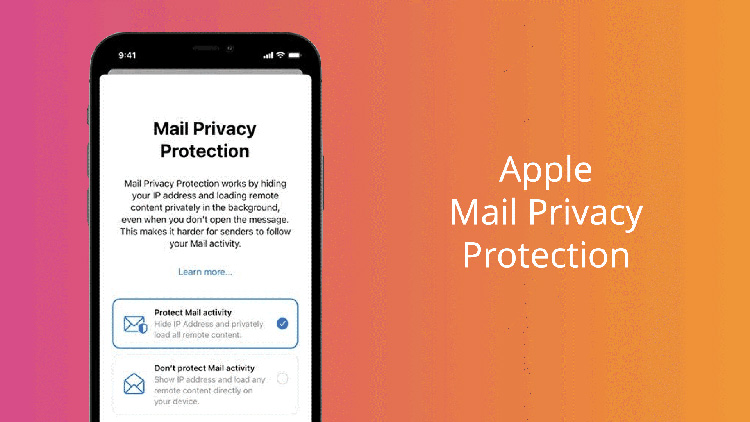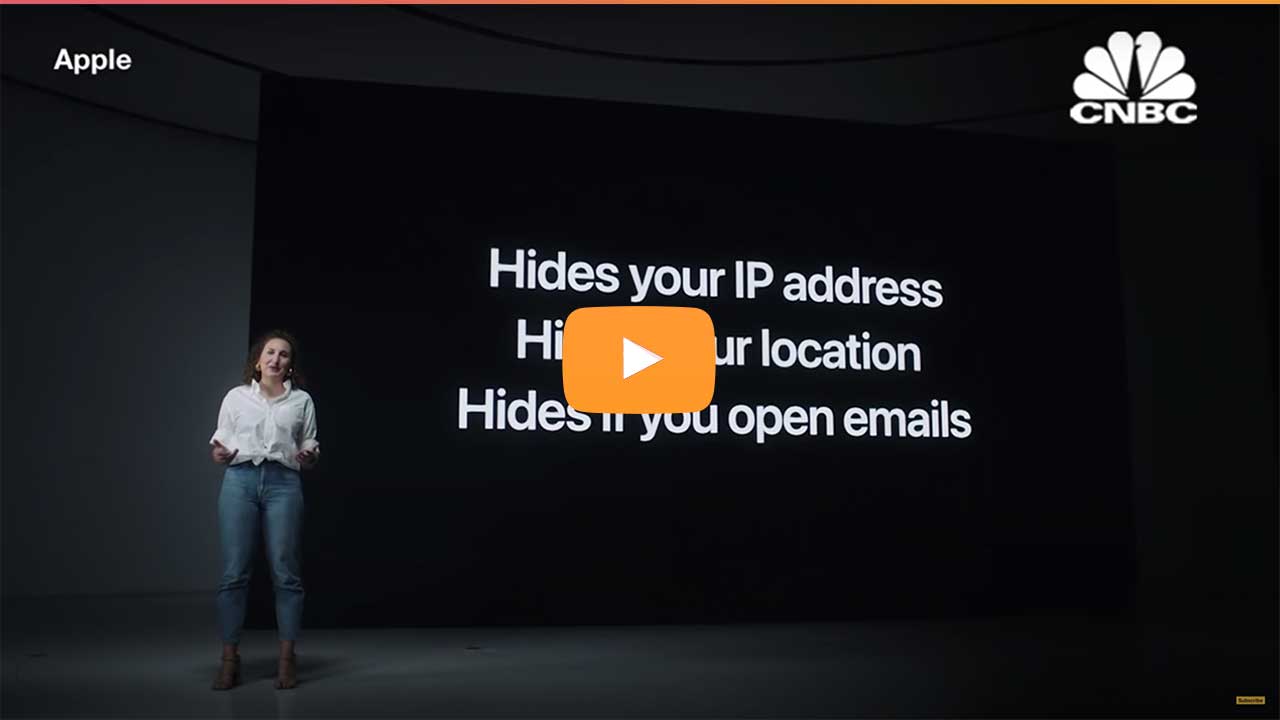Blog
CATEGORY: Newsemail-marketingData Protection
Apple announces the end of email open tracking

At Apple’s annual Worldwide Developer Conference on 7th June, a new feature called Mail Privacy Protection was presented as part of the forthcoming iOS 15.

Mail Privacy Protection
Once iOS 15 is installed, users will be presented with a choice between protecting or not protecting email activity. The iOS 15 user interface infers that, should a user choose to protect their email activity, Apple will use caching to hide how and where the individual interacts with messages in their inbox universally.
"If you've been using remote images to measure the impact of your campaigns, there are a few changes to be aware of. Since mail content may be loaded automatically after delivery, the time of mail viewing will no longer be correct. And since that content is loaded without revealing people's IP addresses and without headers, the location and type of device reading the mail aren't revealed. And you'll see your emails as being opened regardless of if the user read it or not," said Garrett Reid, Apple privacy engineering specialist.
When you sign up to receive newsletters or other forms of email communication from an organisation, you rarely give that organisation informed and specific consent to track your interactions inside their own mailbox, even if it is buried in the privacy notice.
And yet, many software vendors (ourselves included to some extent) extoll the virtues of the insights our tracking technologies bring and how they can help marketers to be more targeted and to better measure results. What goes on in your private mailbox is private and as they have already done with apps, Apple are now going to enforce that privacy.
Last year, a new email service called Hey! was launched, promising a new and privacy focussed email experience. It was widely praised, but adoption was slow, in part, because it is a paid-for service, but also because it does not offer an efficient method to change every corner of the internet where you use your current email address. Hey! also battled with Apple as they circumvented the App Store rules on paid services.
What is unclear at this juncture is whether Apple’s additional privacy protection will apply to any email account used on Apple devices or whether it will be limited to those with an email account hosted by Apple. Many Gmail, Outlook and Yahoo! Mail customers opt to use the Mail app on iOS to access their emails.
If it does apply to all email accounts used on Apple devices, then it will have wide ranging implications beyond just open rates and will effectively mean the most prevalent devices used to read email become a black box from an analytics perspective.
Why are you looking at email opens anyway?
Litmus’ long running Email Client Market Share report estimates Apple devices account for 58% of email opens.
However, this statistic is flawed – open rates have been a self-fulfilling and inaccurate email industry metric for a very long time. Apple may be applying their sizeable influence and technical prowess in fresh and exciting ways, but the option to not load remote images, including the email tracking pixel, has been built into Outlook for a very long time. Less high tech, but just as effective at preventing data coming back from the inbox. This distorts open rates significantly, especially for B2B email marketing.
Back in 2014, Google fundamentally changed the way Gmail worked by caching every image on their own servers – this was, at the time, an up-to-date technical approach to protect privacy of Gmail customers. The email marketing industry adapted to this change eventually by making each tracking image unique, but the principal was the same.
More recently, the amount of non-human interactions with emails has also increased significantly with sophisticated cyber-security tools playing havoc with tracking technologies.
I have been quietly discouraging clients from focussing on open rates for well over a decade. They have always been inaccurate, but it sometimes feels like you’re trying to debunk an element of marketing religion when making this argument. In e-shot, we refer to Open Rates as Display Rates; a small nod toward the inconvenient truth that we are recording how many times a pixel was displayed by man or machine, not how many people actually opened the email.
The end of ‘Spyware’
You’re not a secret agent. You’re a marketing professional. An obsession with covert tracking mechanisms for email and other forms of digital marketing is probably going to become less and less helpful to you, even if it used with good intentions…
You want to optimise your email sends for when and where your subscribers are accessing their inboxes? Sure… You seem to have a lot of people living in server farms in mid-west America! Inbox caching.
You want to trigger a follow up email for those who open the first campaign and then follow up with those who engage? Sure… Your sales team fed back that nobody they followed up with remembers reading any of the emails? Cybersecurity bots.
These are examples of real-world problems with email marketing tactics today. Apple is only going to make them worse. Stop chasing gimmicks that have no bearing on the natural customer journey or on business performance.
What should we do instead?
Keep it simple. Provide a great email experience - Great content. Then, make sure that you have mechanisms in place to encourage those who appreciate your emails to engage with you more – on their terms. Overt enquiry instead of covert surveillance.
One of the best performing campaigns on e-shot in recent months has been for a central government department. Their content is excellent and the intelligent aspects of targeting are all driven by informed choices their subscribers make in setting their preferences.
You can’t improve what you can’t measure
It makes perfect sense that specific measurement of email campaign effectiveness is still required and there will be many things that continue to work as normal. If you do judge or are judged on open rates currently, I encourage you to rethink and begin with the end in mind. Look to measure the performance of your email campaigns based on what they deliver to your organisation. More meaningful performance measurements could include:
e-commerce revenue
event registrations
enquiries
even replies*
*More suited to smaller, targeted campaigns. Use features such as rate control and dynamic reply address to avoid a specific inbox being overwhelmed.
Should we bin open rates?
When I said I have been quietly discouraging clients from focussing on open rates, I do still keep half an eye on them. They contribute to reviewing engagement long term and provide indicative performance metrics for tactics such as subject line split testing.
Nonetheless, they have probably had their day and it is time to move on. I have a strategic development meeting for e-shot in a couple of weeks and will, once again, table the notion of killing them off.
If you’re an e-shot customer, I’d be very keen to get your views on this on this. If you’re not and would like to stay up to date with this and other email marketing insights, you may wish to consider signing up for our newsletter which I believe has a decent open rate… I haven’t checked it in a while though.
Solutions
Email marketing healthcheck
We are confident that we can help you, which is why we offer a free healthcheck to identify potential issues with your current programme and free advice on things that could be done to improve it.


